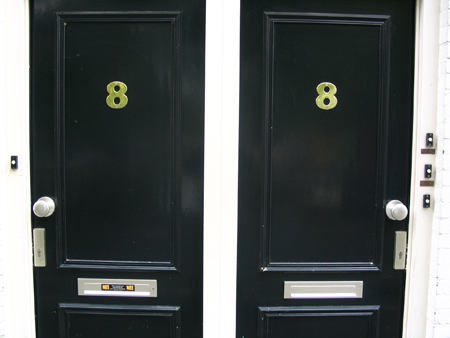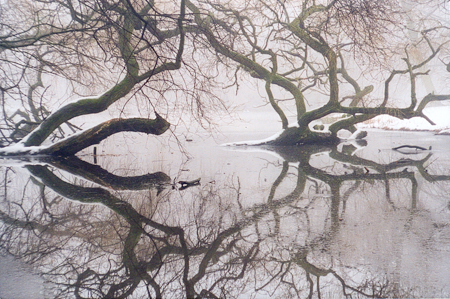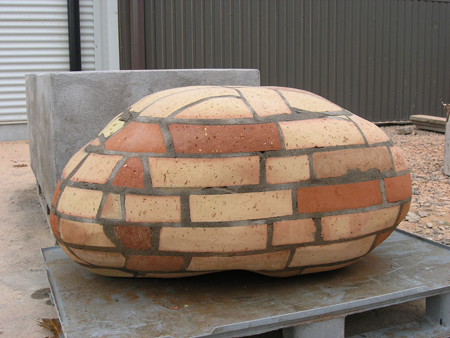Clone the Clone
november 26th, 2007Mark Dion
Lab Bench, 2006
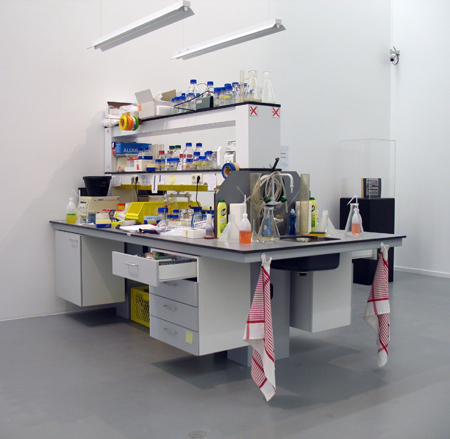
photo: D. Rijper
Mark Dion conducts large-scale projects in which he questions the role of specialists—from archaeologists to ethnologists, from historians to art curators. He questions the classification systems placed on objects by professionals and institutions and invites viewers of his work to be an active audience. Lab Bench is Mark Dion’s perfect imitation or ‘clone’ of the biotechnology laboratory Hubrecht in Utrecht. Could it be used to clone cells? Did he clone a cloning lab? That would be brilliant!
A fictive line separates the bench and literary copies everything form the other ‘original’ side, including personal family photo’s in the open drawer and a left over toast on the table with one bite missing. The work was part of the exhibition Genesis – Life at the end of the information age in the Centraal Museum Utrecht (14/04 – 12/08/2007).
Copy a Copy
november 25th, 2007Andy Warhol
Brillo Boxes, 1969
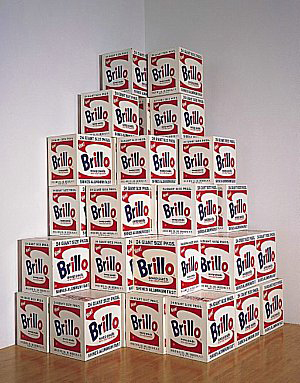
The Moderna Museet, Stockholm’s modern art museum, has determined that six Andy Warhol Brillo boxes in its collection are fakes. They were turned out by carpenters three years after Warhol’s death, at the request of the late Pontus Hulten, the Museum’s famous director in the 1960s, who needed them to promote a show in Russia in 1990. The Museum now claims that Hulten later sold some of the boxes with the false claim that they had been made in 1968 and donated several to the Museum.
The irony in the row is that Warhol himself questioned the idea of “original” art – choosing everyday items as subjects and producing thousands of prints of the same work. Andy Warhol often left assistants to “mass produce” many of his most famous pictures, among them images of the Campbell soup tin.
Campbell’s Soup Cans, 1962
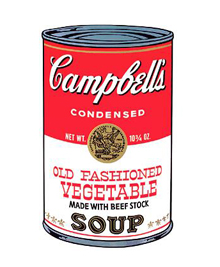

The Andy Warhol Authentication Board has decreed that only artworks the artist was directly involved in producing can be considered a Warhol original, according to reports in the Independent on Sunday and Sunday Telegraph in the UK.
Andy Warhol paintings are among the most prized 20th Century artworks. A screenprint of Campbell’s soup tin fetched £10m at an auction, while a Marilyn Monroe picture from 1967 reached £11m at auction in 1998. Was it really real?
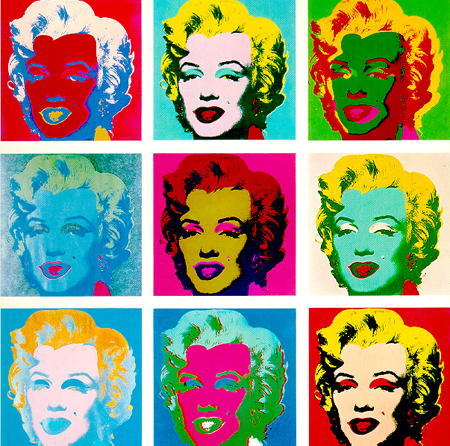
Isn’t life a series of images that change as they repeat themselves?
– Andy Warhol –




The Art of Cloning
november 22nd, 2007Boryana D Rossa
Clone, 1997
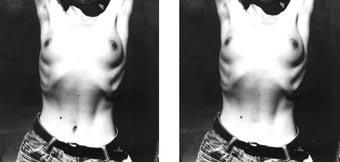
CALResCo
A clone is an identical copy, and thus may be thought to be perfectly predictable (after all we understand the original), but this is a big error. The world is not static but dynamic and thus evolution must be taken into account. Each organism occupies a different space and thus will enjoy different experiences. These lead to changes in the organism itself, chemical, electrical, valuational, etc. which will very rapidly diverge the behaviours of clones (as we see from studies of identical twins). Despite the human desire for predictabilty, this chaos driven divergence is endemic to our coevolutionary world and makes the simplistic predictions of the perpetrators of these ‘improvements’ nonsensical.
In complex systems, plans are simply delusions…
CALResCo promotes free world-wide education about Complex Systems
The Art of Cloning
november 21st, 2007Boryana D Rossa
Clone, 1997

CALResCo
A clone is an identical copy, and thus may be thought to be perfectly predictable (after all we understand the original), but this is a big error. The world is not static but dynamic and thus evolution must be taken into account. Each organism occupies a different space and thus will enjoy different experiences. These lead to changes in the organism itself, chemical, electrical, valuational, etc. which will very rapidly diverge the behaviours of clones (as we see from studies of identical twins). Despite the human desire for predictabilty, this chaos driven divergence is endemic to our coevolutionary world and makes the simplistic predictions of the perpetrators of these ‘improvements’ nonsensical.
In complex systems, plans are simply delusions…
CALResCo promotes free world-wide education about Complex Systems
Cloning Art
november 20th, 2007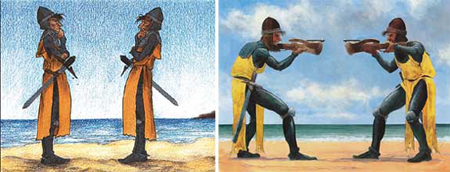
Julie Baroh’s Clone, from Alpha, was an interesting piece rendered in colored pencil that showed two soldiers staring at each other, not sure what to make of one another. Over time, it became one of the more recognizable Magic pieces. Carl Critchlow reiterpreted it (using paint) for the reprint of Clone in Onslaught. Same beach, same clothes, same soldiers, except they now brandish crossbows and look slightly more irritated. A fine homage to the original.
Another well-know piece of art, Morphling by rk post, is similar in appearance to Clone, even though it isn’t a “copy” card per se. Morphling was actually designed to be a sort of “rules-friendly” Clone – a card that could simulate other creatures without actually copying them. That’s why the art is similar to Clone‘s.
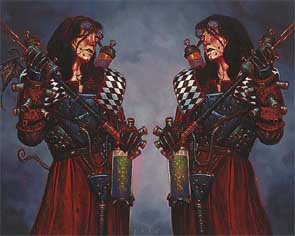
Two other blue cards use mirror image art: Quinton Hoover’s Vesuvan Doppelganger from Alpha (Clone’s big sister), and it’s mild-mannered descendent, Greg Staples’ Shifty Doppelganger from Odyssey.
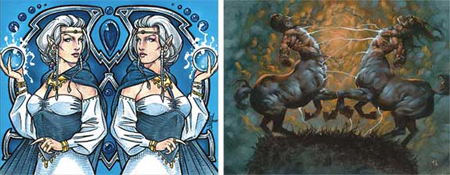
Body Double
november 13th, 2007BEAVERTON, Oregon (CNN) — Oregon researchers say they have cloned a monkey by splitting an early-stage embryo and implanting the pieces into mother animals.
The technique has so far produced only one living monkey, a bright-eyed rhesus macaque female named Tetra, now 4 months old.
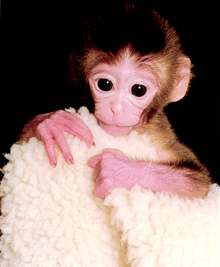

Tetra the monkey is different from Dolly the sheep, which was produced by Scientists at Scotland’s Roslin Institute using a process called nuclear transfer — taking the nucleus out of an adult cell and using it to reprogram an unfertilized egg.
Some scientists argue that animals like Dolly are not 100 percent clones because they have genetic material both from the adult cell they were taken from, and from the egg that is hollowed out to make the clone. Tetra was produced by a technique called “embryo splitting.” Here’s how it works:
* An egg from a mother and sperm from a father are used to create a fertilized egg.
* After the embryo grows into eight cells, researchers split it into four identical embryos, each consisting of just two cells.
* The four embryos are then implanted into surrogate mothers. Schatten said that in effect, a single embryo becomes four embryos, all genetically identical.
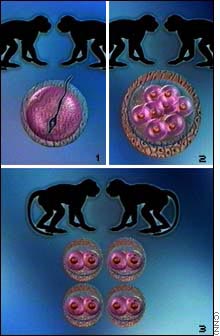
In the case of their experiment, three of the embryos didn’t survive. The fourth, Tetra, was born 157 days later. Her name means “one of four.” Tetra isn’t the first monkey to be cloned, but she is the first using the embryo-splitting technique. More are on the way.
Semi-Living Food
november 7th, 2007Oron Catts and Ionat Zurr
Semi-Living Food: “Disembodied Cuisine”
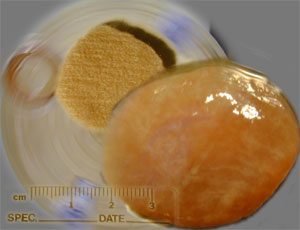
Another way of treating living systems is by consuming them as food. Throughout history many humans have practiced some kind of division among living entities which are categorized as food or others (such as pets, ornaments, work etc.). These divisions are not always clear, and we must practice some kind of hypocrisy in order to be able to love and respect living things as well as to eat them.
Our latest project titled ‘Disembodied Cuisine’ will be shown in an international biological art exhibition” L’art Biotech’ in Nantes, France March 2003. In the “Disembodied Cuisine” we will attempt to grow frog skeletal muscle over biopolymer for potential food consumption. A biopsy will be taken from an animal which will continue to live and be displayed in the gallery along side the growing “steak”. This installation will culminate in a “feast”. The idea and research into this project began in Harvard in 2000. The first steak we have grown was made out of pre-natal sheep cells (skeletal muscle). We used cells harvested as part of research into tissue engineering techniques in utero. The steak was grown from an animal that was not yet born.
This piece deals with one of the most common zones of interaction between humans and other living systems and will probe the apparent uneasiness people feel when someone ‘messes’ with their food. Here the relationships with the Semi-Living are that of consumption and exploitation however, it is important to note that it is about “victimless” meat consumption. As the cells from the biopsy proliferate the ‘steak’ in vitro continues to grow and expand, while the source, the animal from which the cells were taken, is healing. Potentially this work presents a future in which there will be meat (or protein rich food) for vegetarians and the killing and suffering of animals destined for food consumption will be reduced. Furthermore, ecological and economical problems associated with the food industry (hence, growing grains to feed the animals and keeping them in basic conditions) can be reduced dramatically. However, by making our food a new class of object/being – a Semi-Living – we are risking of making the Semi-Living the new class for exploitation.

Ian Sample, science correspondent of The Guardian
It is the ultimate conundrum for vegetarians who think that meat is murder: a revolution in processed food that will see fresh meat grown from animal cells without a single cow, sheep or pig being killed. Researchers have published details in a biotechnology journal describing a new technique which they hailed as the answer to the world’s food shortage. Lumps of meat would be cultured in laboratory vats rather than carved from livestock reared on a farm.
Scientists have adapted the cutting-edge medical technique of tissue engineering, where individual cells are multiplied into whole tissues, and applied them to food production. “With a single cell, you could theoretically produce the world’s annual meat supply,” said Jason Matheny, an agricultural scientist at the University of Maryland.
The idea of doing away with traditional livestock and growing steaks from scratch dates back at least 70 years. In a horizon-scanning essay from 1932, Winston Churchill said: “Fifty years hence we shall escape the absurdity of growing a whole chicken in order to eat the breast or wing by growing these parts separately under a suitable medium.” Several decades too late, Churchill’s vision finally looks set to become a reality.
Lab-raised steaks will be off the menu for some time though. Scientists believe that while tissue engineering is advanced enough to grow bland, homogeneous meat, tasty and textured cuts will have to wait.
Eslöv Meteorite
november 3rd, 2007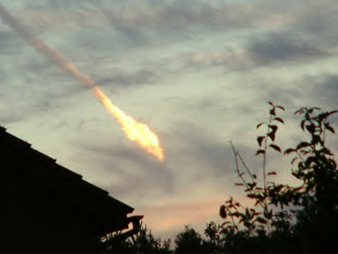
meteor impact at 06.41 am
In the early morning of the 3rd of november 2007 a meteor hit Eslöv, known as the most boring town of Sweden. It was an unexpected event that was witnessed only by a few. The energy of the blast was estimated to be between 1 and 2 megatons of TNT and left a hole of 15 metres in diameter in a field near Eslöv. The meteorite was dug up by Maarten Vanden Eynde and put on display in front of the Medborgarhuset in the framework of the 2nd Eslöv Biennale.
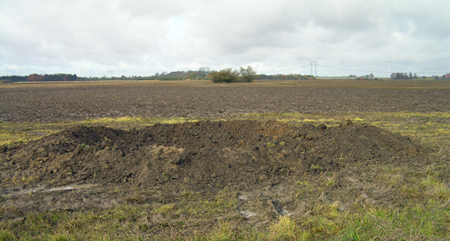
meteor crater near Eslöv
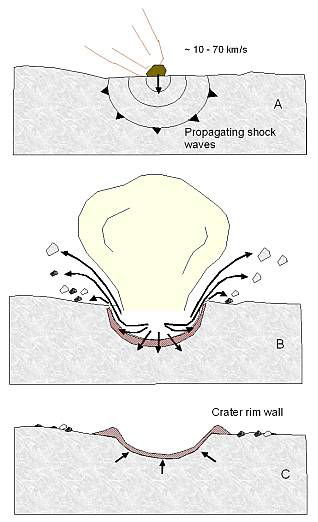
Eslöv Biennale II
03/11 – 30/11/2007: Medborgarhuset, Eslöv, Sweden
The 2007 Biennale is a wide exhibition that offers a regional and national sample of the art of today with international flavours. The elements of the Biennale is like a sweep through the art-world with everything from visual art to sound-art, conceptualism and performance. The location for the Biennale is part of the experience. Medborgarhuset (Civic Hall) has flourished during the last year and is building a reputation as a centre of events. In architectural circles the Civic Hall in Eslöv is known as the most ambitious building in Sweden in the post-war period. It was 1947 when the young, newly-qualified architect Hans Asplund´s proposal won the competition to design Eslöv´s Civic Hall, which was built and completed in 1957. At the same time he build the United Nations building in New York for which he used many similar materials.
Victimless Leather Jacket
oktober 26th, 2007Oron Catts and Ionat Zurr
Victimless Leather- A Prototype of Stitch-less Jacket grown in a Technoscientific “Body”
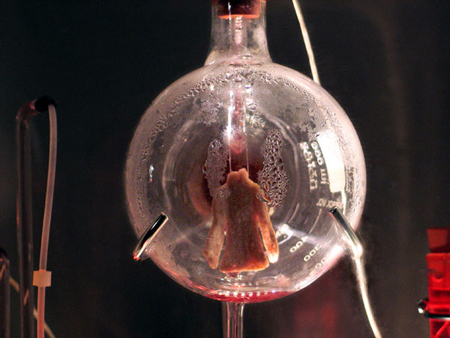
Humans, the naked/nude apes, have been covering their fragile bodies/skins to protect themselves from the external environment. This humble act for survival has developed into a complex social ritual which transformed the concept of a “Garment” into an evocative object that cannot be taken on its face value. Garment became an expressive tool to project one’s identity, social class, political stand and so on. Garments are humans’ fabrication and can be explored as a tangible example of humans’ treatment of the Other.
By growing Victimless Leather, the Tissue Culture & Art (TC&A) Project is further problematising the concept of garment by making it Semi-Living. The Victimless Leather is grown out of immortalised cell lines which cultured and form a living layer of tissue supported by a biodegradable polymer matrix in a form of miniature stich-less coat like shape. The Victimless Leather project concerns with growing living tissue into a leather like material.
This artistic grown garment will confront people with the moral implications of wearing parts of dead animals for protective and aesthetic reasons and will further confront notions of relationships with living systems manipulated or otherwise. An actualized possibility of wearing ‘leather’ without killing an animal is offered as a starting point for cultural discussion.
Our intention is not to provide yet another consumer product but rather to raise questions about our exploitation of other living beings. We see our role as artists as one in which we are providing tangible example of possible futures, and research the potential affects of these new forms on our cultural perceptions of life. It is not our role to provide people with goods for their daily use. We would like our work to be seen in this cultural context, and not in a commercial context.
As part of the TC&A project we are artistically exploring and provoking notions relating to human conduct with other living systems, or to the Other. This particular project will deconstruct our cultural meaning of clothes as a second skin by materialsing it and displaying it as an art object.
This piece also presents an ambiguous and somewhat ironic take into the technological price our society will need to pay for achieving “a victimless utopia”.
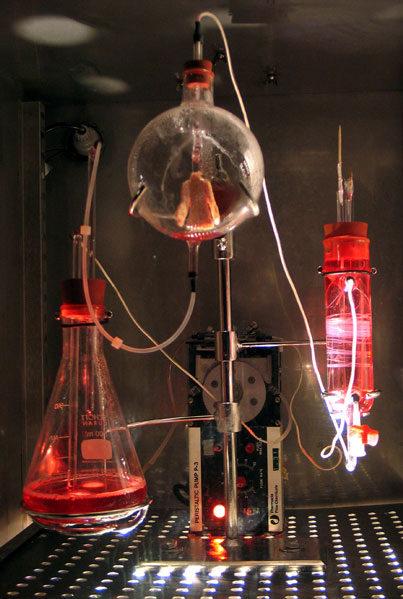
The research and development of “Victimless Leather” has been conducted in SymbioticA: the Art and Science Collaborative Research Laboratory, School of Anatomy and Human Biology at the University of Western Australia and in consultation with Professor Arunasalam Dharmarajan from the School of Anatomy and Human Biology as well as Verigen, a Perth based company that specializes in tissue engineered cartilage for clinical applications. The State of Western Australia has made an investment in this project through ArtsWA in Association with the Lotteries Commission.
Transgenics
oktober 3rd, 2007Eduardo Kac
Genesis, 1999-2003

Transgenics is a field of biomedical research transforming the use of test animals. It involves the genetic modification, cloning, and breeding of animals for specific use in testing. It can involve the production of specific cell matter via breeding and DNA recombination, so future tests can be conducted on cells alone without a living host. Transgenecists often computer clone the cells and conduct their research via electronic simulation, so that researchers in labs around the world can be involved in team experiments taking place in real-time.
To create the key element of his work “Genesis,” bioartist Eduardo Kac translated a sentence from the book of Genesis into Morse code and converted the code into DNA base pairs according to a conversion principle he specially developed for the work.
“Let man have dominion over the fish of the sea, and over the fowl of the air, and over every living thing that moves upon the earth.” (Genesis 1:26, the Bible)
He then implanted the resulting “artist’s gene” into an unspecified bacteria, placed it in a Petri dish and allowed online viewers to cause—through the use of ultraviolet light—real, biological mutations in the bacteria. This action changed the biblical sentence in the bacteria as well, leading Kac to declare on his web site:
“The ability to change the sentence is a symbolic gesture: it means that we do not accept its meaning in the form we inherited it and that new meanings emerge as we seek to change it.”
Do you want to play God? Go to: http://genesis.ivam.es/
The Future Farm
september 27th, 2007Alexis Rockman
The Farm, 2000
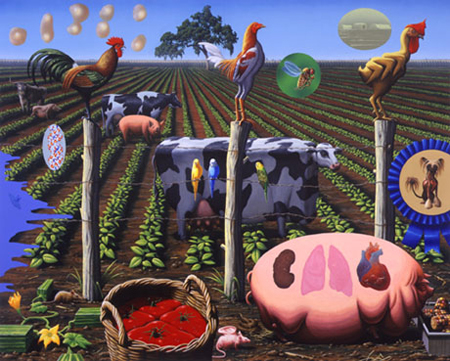
oil and acrylic on wood panel, 96 x 120 in.
Courtesy of JGS, Inc.
‘My artworks are information-rich depictions of how our culture perceives and interacts with plants and animals, and the role culture plays in influencing the direction of natural history.
The Farm contextualizes the biotech industry’s explosive advances in genetic engineering within the history of agriculture, breeding, and artificial selection in general. The image, a wide-angle view of a cultivated soybean field, is constructed to be read from left to right. The image begins with the ancestral versions of internationally familiar animals, the cow, pig, and chicken, and moves across to an informed speculation about how they might look in the future. Also included are geometrically transformed vegetables and familiar images relating to the history of genetics. In The Farm I am interested in how the present and the future look of things are influenced by a broad range of pressures- human consumption, aesthetics, domestication, and medical applications among them. The flora and fauna of the farm are easily recognizable; they are, at the same time, in danger of losing their ancestral identities’.
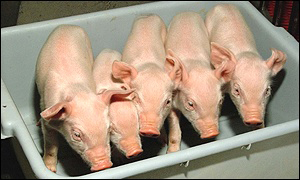
Five cloned piglets: Noel, Angel, Star, Joy and Mary
Born on Christmas Day 2001 in the US Scottish-based firm PPL Therapeutics
These are not the first pig clones, but PPL, a commercial offshoot of the Roslin Institute in Scotland, says the pigs are the first to be engineered in a way that should help prevent their tissues being rejected by the human body.
The animals’ biological make-up is slightly different from ordinary pigs. PPL says that it intends to use the pigs as part of its programme to seek a cure for humans suffering from diabetes.
Indianography
september 26th, 2007Brian Jungen
Prototypes for New Understanding, 1998-2005
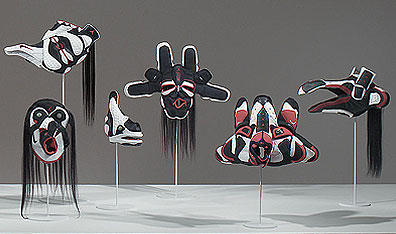
Prototypes for New Understanding, Jungen’s series of West Coast Aboriginal masks made entirely from re-stitched Air Jordans, highlights his debut North American survey, an exhibit at the New Museum of Contemporary Art in New York City. Conflating the transformative power of ceremonial masks with Nike consumers’ desire to emulate or become sport stars by wearing a particular brand of trainers, Jungen plays with economic and cultural values, revealing the power of contemporary ‘idols’ and linking colonial history with today’s Third World sweatshop labor.
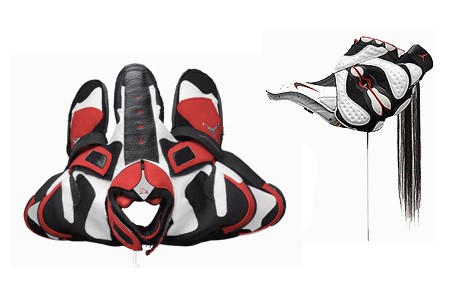
Nike Designs Shoe for American Indians
By SARAH SKIDMORE
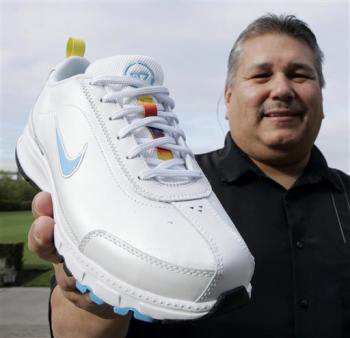
BEAVERTON, Ore. (AP) — Nike on Tuesday unveiled what it said is the first shoe designed specifically for American Indians, an effort aiming at promoting physical fitness in a population with high obesity rates.
The Beaverton-based company says the Air Native N7 is designed with a larger fit for the distinct foot shape of American Indians, and has a culturally specific look. It will be distributed solely to American Indians; tribal wellness programs and tribal schools nationwide will be able to purchase the shoe at wholesale price and then pass it along to individuals, often at no cost.
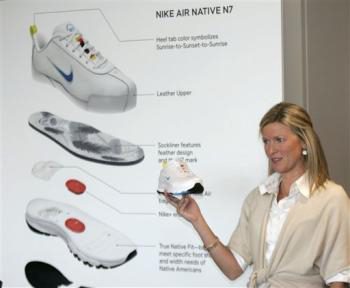
“Nike is aware of the growing health issues facing Native Americans,” said Sam McCracken, manager of Nike’s Native American Business program. “We are stepping up our commitment … to elevate the issue of Native American health and wellness.”
Nike said it is the first time it has designed a shoe for a specific race or ethnicity. It said all profits from the sale of the shoe will be reinvested in health programs for tribal lands, where problems with obesity, diabetes and related conditions are near epidemic levels in some tribes.
Nike designers and researchers looked at the feet of more than 200 people from more than 70 tribes nationwide and found that in general, American Indians have a much wider and taller foot than the average shoe accommodates. The average shoe width of men and women measured was three width sizes larger than the standard Nike shoe.
As a result, the Air Native is wider with a larger toe box. The shoe has fewer seams for irritation and a thicker sock liner for comfort.
The N7 name is a reference to the seventh generation theory, used by some tribes to look to the three generations preceding them for wisdom and the three generations ahead for their legacy. The design features several “heritage callouts” as one product manager described it, including sunrise to sunset to sunrise patterns on the tongue and heel of the shoe. Feather designs adorn the inside and stars are on the sole to represent the night sky.
“It reinforces the core of the Nike brand, which is: If you have a body you are an athlete,” Paul Swangard, managing director of the Warsaw Sports Marketing Center at the University of Oregon
Associated Press writer William McCall contributed to this report from Portland, Ore.
Interactive Plant Growing
september 26th, 2007Christa Sommerer & Laurent Mignonneau
Interactive Plant Growing, 1993-97
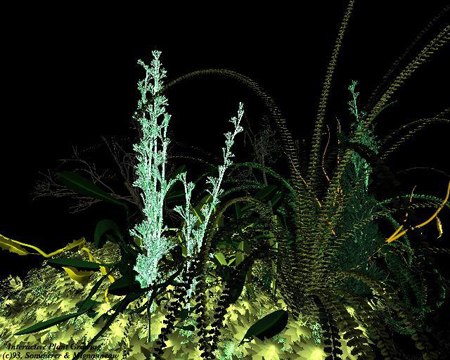
in permanent collection of the ZKM Media Museum, Karlsruhe
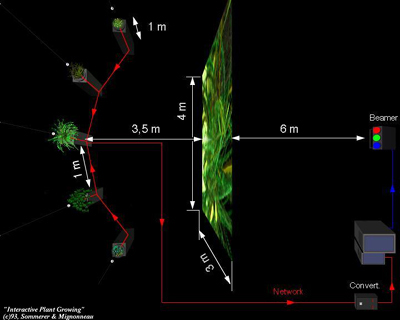
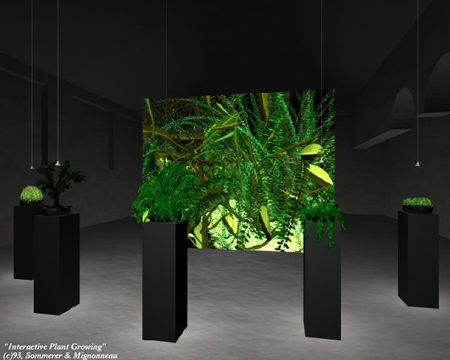
Conceptual and aesthetic aspects :
“The rate of growth deserves to be studied as a necessary preliminary to the theoretical study of form, and organic form itself is found, mathematically speaking, to be a function of time. (….) We might call the form of an organism an event in space-time, and not merely a configuration in space.” (D´Arcy Thompson,On Growth and Form, Cambridge University Press,1942.)
“Interactive Plant Growing” is an installation, which deals with the principle of the growth of virtual plant organisms and their change and modification in real time in the 3-dimensional virtual space of a 4D Graphics Computer (Silicon Graphics). These modifications of predefined “artificially living plant organisms” are mainly based on the principle of development and evolution in time. The artificial growing of program – based plants is an expression of the desire to discover the principle of life, which is always defined by the transformations and morphogenesis of certain organisms.
Interactive Plant Growing connects the real time growing of virtual plants in the 3 – dimensional space of the computer to real living plants, which can be touched or approached by human viewers.differentiation.
1 ) Interaction Human – Plant :
By touching real plants or moving their hands towards them human viewers can influence and control in real time the virtual growth of 25 and more program – based plants, which are simultaneously displayed on a video screen in front of the viewers. By producing a sensitive interaction with the real plants, the viewers too become part of the installation. They decide how this interaction is translated to the screen and how growth takes place on the screen.
The various distance modulations of the viewer´s hands directly effect the appearance of the virtual plants, as they are ferns, mosses, trees, vines and a cleaning plant (“killer plant”).
By sending different data values to the interface (which connects the plants and the growing program), the appearance of the virtual plants can be modified and varied . The viewers can control the size of the virtual plants, direct the rotation, modify the appearance, change the colours and control new positions for the same type of plant.
Each virtual plant species has at least 6 different variations, but generally there are more possibilities than just 25 variations of 5 plants, since the size, colour and translation can be modified for each single plant as well.
All variations ultimately depend on the viewers sensibility to find the different levels of approximation distances, as they are responsible for the different events in growing.
Since it takes some time for the viewer to discover the different levels for modulating and building the virtual plants, he will develop a higher sensitivity and awareness for real plants.
2) Programming :
In Interactive Plant Growing artificial plants, programmed by Laurent Mignonneau and Christa Sommerer on Silicon Graphics Computer, grow in a virtual 3 – dimensional space.
This virtual growing is based on specially developed algorithms, according to the different morphological characteristics of real plant differentiation.
Virtual growing is not based on the same principles as real growing, rather the appearance of movement and differentiation and determination during this evolutionary process can be considered to be optically similar.
In the program a new method of differentiation was developed, using special randomising parameters, which are seen as “artificial growth and differentiation regulators”.
These randomising parameters determine the morphology of the organisms by controlling their variations of forms.
This leads us to different botanical growth forms. Plants like ferns, vine or mosses change their appearance depending on the randomising defined variables for size, length, rotation, translation, angle and colour.
This idea of advanced randomising could be compared with the term “walking randomising”.
The limits of randomising could be considered as determination, whereas the human – plant randomising itself can be representative for the differentiation.
3 ) Technique :
Technically speaking, the electrical potential difference between human and plant gets measured through the living plants.
This voltage difference varies depending on the hand – plant distance, the sensitivity of the plant ranges from 0 to about 70 cm in space, depending on the size and morphology of the real plant.
A special protocol (interface program) between computer and converter makes sure, that each data value coming from each plant is interpreted in synchronisation and in real time by means of the growing program during the drawing of the virtual plants.
All data values (derived from the interaction viewer – plant) are now interpreted as variables in the growing program. Each value is responsible for specific growing events; changing rotation, scaling, translation, location or colour.
4 ) Installation space :
In the dark 12 x 6 meter installation space, five different real plants are placed on 5 wooden columns in front of a high resolution 4 x 3 meter video projection screen. All plants are connected by an interface to a 4D Silicon Graphics computer, which sends its video signals from the screen to a high resolution RGB video data beamer 80 kHz , 650 Lux. This data beamer sends the growing pictures to the projection screen in real time.
5 ) Feedback :
By the feedback of the virtual growth on the screen, the viewers can react to these events and control and modify the growing process. Five or more people can interact at the same time with the 5 real plants in the installation space. All events depend exclusively on the human-plant interaction.
“Interactive Plant Growing” (c) 92-97, Christa Sommerer & Laurent Mignonneau
